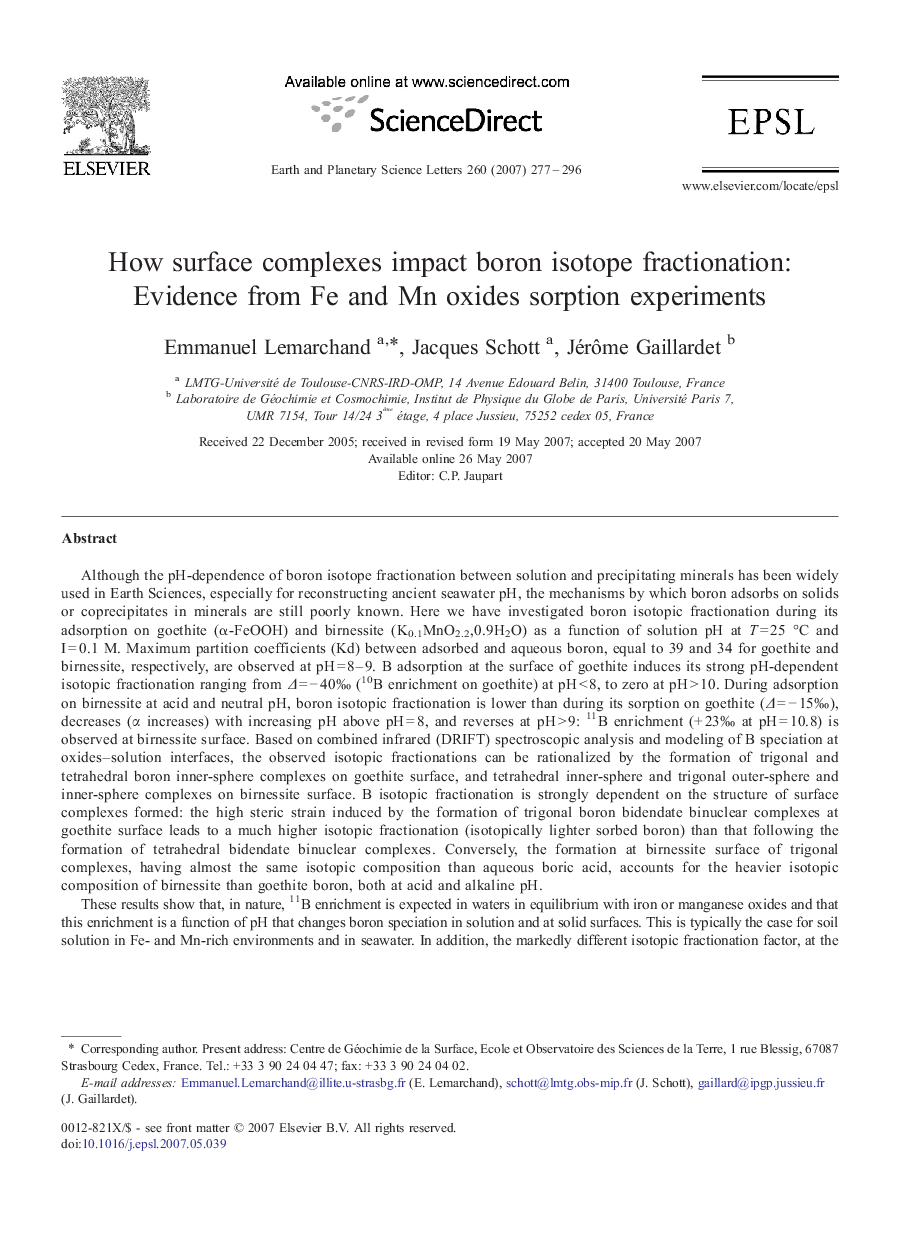| کد مقاله | کد نشریه | سال انتشار | مقاله انگلیسی | نسخه تمام متن |
|---|---|---|---|---|
| 4680266 | 1634915 | 2007 | 20 صفحه PDF | دانلود رایگان |

Although the pH-dependence of boron isotope fractionation between solution and precipitating minerals has been widely used in Earth Sciences, especially for reconstructing ancient seawater pH, the mechanisms by which boron adsorbs on solids or coprecipitates in minerals are still poorly known. Here we have investigated boron isotopic fractionation during its adsorption on goethite (α-FeOOH) and birnessite (K0.1MnO2.2,0.9H2O) as a function of solution pH at T = 25 °C and I = 0.1 M. Maximum partition coefficients (Kd) between adsorbed and aqueous boron, equal to 39 and 34 for goethite and birnessite, respectively, are observed at pH = 8–9. B adsorption at the surface of goethite induces its strong pH-dependent isotopic fractionation ranging from Δ = − 40‰ (10B enrichment on goethite) at pH < 8, to zero at pH > 10. During adsorption on birnessite at acid and neutral pH, boron isotopic fractionation is lower than during its sorption on goethite (Δ = − 15‰), decreases (α increases) with increasing pH above pH = 8, and reverses at pH > 9: 11B enrichment (+ 23‰ at pH = 10.8) is observed at birnessite surface. Based on combined infrared (DRIFT) spectroscopic analysis and modeling of B speciation at oxides–solution interfaces, the observed isotopic fractionations can be rationalized by the formation of trigonal and tetrahedral boron inner-sphere complexes on goethite surface, and tetrahedral inner-sphere and trigonal outer-sphere and inner-sphere complexes on birnessite surface. B isotopic fractionation is strongly dependent on the structure of surface complexes formed: the high steric strain induced by the formation of trigonal boron bidendate binuclear complexes at goethite surface leads to a much higher isotopic fractionation (isotopically lighter sorbed boron) than that following the formation of tetrahedral bidendate binuclear complexes. Conversely, the formation at birnessite surface of trigonal complexes, having almost the same isotopic composition than aqueous boric acid, accounts for the heavier isotopic composition of birnessite than goethite boron, both at acid and alkaline pH.These results show that, in nature, 11B enrichment is expected in waters in equilibrium with iron or manganese oxides and that this enrichment is a function of pH that changes boron speciation in solution and at solid surfaces. This is typically the case for soil solution in Fe- and Mn-rich environments and in seawater. In addition, the markedly different isotopic fractionation factor, at the same pH, of boron sorbed on goethite and birnessite (at pH = 8.2, α is equal to 0.967 and 0.986 for goethite and birnessite, respectively) may be used to determine past ocean pH values without requiring knowledge of past isotopic composition.
Journal: Earth and Planetary Science Letters - Volume 260, Issues 1–2, 15 August 2007, Pages 277–296